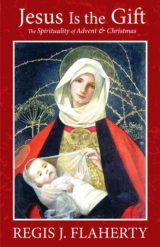By Regis Flaherty
Regis Flaherty is a bestselling author of several books, including Jesus Is the Gift: The Spirituality of Advent & Christmas, which is the fruit of over seven years of preparing others for Advent through talks on its liturgical themes.

Can there be a greater gift than God becoming man so that humanity could be reunited with God? Gratitude for that greatest Gift has been the inspiration for other gift-giving at Christmas.
A favorite gift-giver whose story is retold in a popular Christmas song is King Wenceslaus. The legend states that the king saw a poor man gathering wood during Christmastime. The good king had his servant gather provisions, which Wenceslaus personally delivered to the poor family. A king bent low to meet the needs of his subjects, having learned well from the King of kings, Jesus, the meaning of love and giving.
Today the meaning behind the giving of gifts can be lost in commercialism. Nevertheless, many charitable organizations now encourage and facilitate the giving of gifts to the poor during the Yuletide season—a practice that recalls the original intent of the custom.
Various saints are associated with Christmas, including the Holy Innocents martyred by King Herod when he sought to kill the Christ Child. But the saint most often associated with Christmas is Saint Nicholas.
Nicholas was a bishop of Myra in Asia Minor during the fourth century. He was imprisoned when Emperor Diocletian was persecuting Christians. Since the bishop’s death, a long tradition of miracles has been attributed to his intercession.
Nicholas is best remembered for his generosity. Legend affirms that he was from a wealthy family, but even as a layman he gave all his possessions to the poor. One legend says that when he heard of a poor family with three unmarried daughters, Nicholas secretly tossed a bag of gold through the window of the home so that the family could provide the necessary dowry for a wedding. The gold reportedly fell into a stocking that was hanging inside from the window sill—the origin, some say, of the Christmas tradition of filling stockings with goodies.
Later, as bishop, Nicholas continued to assist the poor. He visited prisoners and sailors in the port city. He especially took a concern to meet the needs of children. Although the modern Santa Claus character developed from various roots, his relationship to Saint Nicholas and the saint’s gift-giving is clear.
A number of Christmas traditions have roots in faith and in the birth of Christ. Gift-giving is only one example. Yet not all Christmas traditions have an explicitly spiritual origin, and some with spiritual roots have lost their religious meanings over time.
Some Christmas traditions even have pagan roots. The Christmas tree is an example here. It started as a pagan custom, but was adapted for Christian usage. Many such non-religious traditions have been given a Christian meaning to enhance the Christian celebration.
Sometimes Catholics struggle with celebrating Christmas because the true meaning of the season can be lost amidst all the commercial hype surrounding the holiday. Perhaps the key to a meaningful season is to rediscover the religious character of Christmas traditions. In addition, Catholics can implement new traditions at home that help to keep a healthy focus on the true significance of Christmas: God became man as an infant in Bethlehem.
You Might Also Like

Jesus is the Gift: The Spirituality of Advent and Christmas explores the biblical characters that the Church presents in these liturgical seasons of grace. Author Regis Flaherty helps the reader to walk in their footsteps—to understand the themes of Advent and Christmas, to prepare for the coming of our Lord, and to embrace His plan for our lives. You’ll find inspiration, opportunity, and impetus to prayer and conversion. This is a great book to help all Catholics prepare for and enter into Advent.

